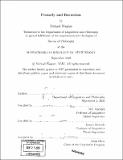| dc.contributor.advisor | Alex Marantz and Donca Steriade. | en_US |
| dc.contributor.author | Wagner, Michael, Ph. D. Massachusetts Institute of Technology | en_US |
| dc.contributor.other | Massachusetts Institute of Technology. Dept. of Linguistics and Philosophy. | en_US |
| dc.date.accessioned | 2006-07-31T15:26:34Z | |
| dc.date.available | 2006-07-31T15:26:34Z | |
| dc.date.copyright | 2005 | en_US |
| dc.date.issued | 2005 | en_US |
| dc.identifier.uri | http://hdl.handle.net/1721.1/33713 | |
| dc.description | Thesis (Ph. D.)--Massachusetts Institute of Technology, Dept. of Linguistics and Philosophy, 2005. | en_US |
| dc.description | Includes bibliographical references (p. 317-341). | en_US |
| dc.description.abstract | This thesis proposes a recursive mapping of syntactic derivations to prosodic representations. I argue that the prosody of an expression, just like its meaning, is determined compositionally, as originally proposed in Chomsky et al. (1957), Chomsky and Halle (1968). Syntactic structure are cyclically spelled out and assigned a semantic and phonological interpretation. The cyclic approach is motivated based on data from the prosody of coordinate structures, integrating insights from syntax, combinatorics, and semantics. The algorithm distinguishes two ways of prosodically relating the output of cyclic domains: they can either be mapped to prosodic domains that are on a par and match in prosodic status: PROSODIC MATCHING; or the output of one cycle can be prosodically subordinated to another cycle: PROSODIC SUBORDINATION. Together, they derive a metrical structure that encodes information about phrasing, accent placement, and prominence. Scope relations, argument structure, and information structure affect prosodic phrasing indirectly by determining which of the two principles applies and when a syntactic cycle is spelled out. The derived metrical representation is a relational grid (Liberman, 1975). | en_US |
| dc.description.abstract | (cont.) It encodes syntactic structure and also the derivational history of how it was assembled. The theory attempts to incorporate insights from recent work on stress and prominence (Cinque, 1993, Arregi, 2002) and prosodic recursion Ladd (1988), Dresher (1994), as well as insights from the research on prosodic phrasing and phrasal phonology (Gussenhoven, 1984, Selkirk, 1986, Truckenbrodt, 1995). Phonetic evidence from on-line production is presented to show that speakers implement the predicted metrical relations and scale boundaries later in the utterance relative to boundaries already produced, a phenomenon dubbed BOUNDARY STRENGTH SCALING. | en_US |
| dc.description.statementofresponsibility | by Michael Wagner. | en_US |
| dc.format.extent | 341 p. | en_US |
| dc.format.extent | 17873731 bytes | |
| dc.format.extent | 17888790 bytes | |
| dc.format.mimetype | application/pdf | |
| dc.format.mimetype | application/pdf | |
| dc.language.iso | eng | en_US |
| dc.publisher | Massachusetts Institute of Technology | en_US |
| dc.rights | M.I.T. theses are protected by copyright. They may be viewed from this source for any purpose, but reproduction or distribution in any format is prohibited without written permission. See provided URL for inquiries about permission. | en_US |
| dc.rights.uri | http://dspace.mit.edu/handle/1721.1/7582 | |
| dc.subject | Linguistics and Philosophy. | en_US |
| dc.title | Prosody and recursion | en_US |
| dc.type | Thesis | en_US |
| dc.description.degree | Ph.D. | en_US |
| dc.contributor.department | Massachusetts Institute of Technology. Department of Linguistics and Philosophy | |
| dc.identifier.oclc | 64704683 | en_US |
